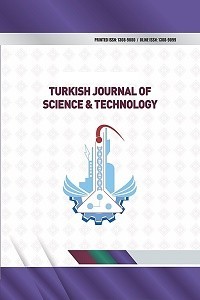Implementation of Two Cell Non-Autonomous CNN Model on FPGA
Implementation of Two Cell Non-Autonomous CNN Model on FPGA
Cellular Neural Network Chaos, FPGA, Random Number Generator,
___
- 1. Strogatz S.H., Herbert D.E., (1996). Nonlinear dynamics and chaos. Medical Physics-New York-Institute of Physics, 23(6), 993-995. 2. Natsheh A.N., Al-Habibah E.M.S., (2015). Chaos control DC-DC boost converter by FPGA. 2015 IEEE 42nd Photovoltaic Specialist Conference (PVSC), New Orleans, LA, 1-6. 3. Hidalgo R.M., Fernndez J.G., Rivera R.R., Larrondo H.A., (2001). Versatile dsp-based chaotic communication system. Electronic Letters, 37, 1204–1205. 4. Ali-Pacha A., Said N.H., M’Hamed A., Belgoraf A., (2007). Lorenz’s attractor applied to the stream cipher (alipacha generator). Chaos, Solitons and Fractals, 33(5), 1762-1766. 5. Mazzini G., Setti G., Rovatti R., (1997). Chaotic complex spreading sequences for aynhchronous ds-cdma-part 1: System modeling and results. IEEE Trans. Circuits Sys. 1, 44(10), 937–947. 6. Setti G., Balestra M., Rovatti R., (2000). Experimental verification of enhanced electromagnetic compatibility in chaotic fm clock signals. in Proceedings of ISCAS’00. IEEE Circuits and Systems Society, III-229–232. 7. Gonz´alez C.M., Larrondo H.A., Gayoso C.A., Arnone L.J., (2003). Generaci´on de secuencias binarias pseudo aleatorias por medio de un mapa ca´otico 3d. in Proceedings del IX Workshop de IBERCHIP. 8. De Micco L., Zabaleta O.G., Gonzlez C.M., Arizmendi C.M., Larrondo H.A., (2010). Estocasticidad de un atractor catico determinista implementado en fpga. Proceedings Iberchip. 9. De Micco L., Larrondo H.A., (2011). FPGA implementation of a chaotic oscillator using RK4 method. 2011 VII Southern Conference on Programmable Logic (SPL), Cordoba, 185-190.doi: 10.1109/SPL.2011.5782646. 10. Merah L., Ali-Pacha A., Said N.H., Mamat M., (2013). Design and FPGA implementation of Lorenz chaotic system for information security issues. Applied Mathematical Sciences, 7(5), 237-246. 11. Chua L.O., Yang L., (1988). Cellular neural networks: Theory. IEEE Trans. Circuits Syst., 35, 1257-1272. 12. Chua L.O., Yang L., (1988). Cellular neural networks: applications. IEEE Transactions on Circuits and Systems, 35(10), 1273-1290. 13. Zou F., Nossek J.A., (1993). Bifurcation and chaos in cellular neural networks. IEEE Transactions on Circuits and Systems I: Fundamental Theory and Applications, 40(3), 166-173. 14. Zou F., Nossek J.A., (1991). A chaotic attractor with cellular neural networks. in IEEE Transactions on Circuits and Systems, 38(7), 811-812. 15. Gerosa A., Bernardini R., Pietri S., (2001). A fully integrated 8-bit, 20MHz, truly random numbers generator, based on a chaotic system. In: Proceedings of the Southwest Symposium on Mixed-Signal Design, SSMSD, 87–92. 16. Karakaya B., Yeniceri R., Yalcin M.E., (2015). Wave computer core using fixed-point arithmetic. 2015 IEEE International Symposium on Circuits and Systems (ISCAS), Lisbon, 1514-1517.
- ISSN: 1308-9080
- Başlangıç: 2009
- Yayıncı: Fırat Üniversitesi
Mustafa Ülker, Ercan Işık, Mehmet Ülker
Taner ALATAŞ, Mehmet YİLMAZ, Baha Vural KÖK
Determination of Friction Angles Between Soil and Steel - FRP Piles
H. Suha AKSOY, Mesut GÖR, Esen İNAL
CFD Analysis of Ilısu Dam Sluice Outlet
M. Cihan AYDİN, Ali Emre ULU, Çimen KARADUMAN
Investigation of Soft Stories in Buildings with Hollow Block Slab
Ozan Ince, Humeyra Sahin, Kursat Esat Alyamac, Zulfu Cinar Ulucan
Deformation Measurements and Analysis with Robust Methods: A Case Study, Deriner Dam
Berkant KONAKOĞLU, Ertan GÖKALP
Kürşat Esat ALYAMAÇ, Merve AÇIKGENÇ ULAŞ, Yavuzhan TAŞ, Ehsan GHAFARİ
Determination of Fracture Paramaters of Effective Crack Model by Wedge-Splitting Test
Implementation of Two Cell Non-Autonomous CNN Model on FPGA
